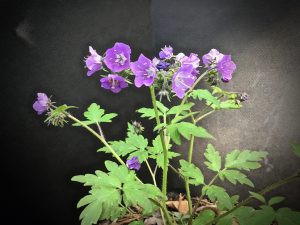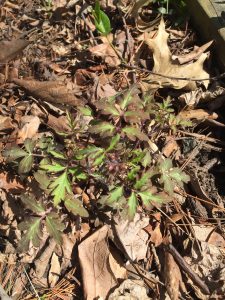Last month I mentioned detecting the mottled green leaves of Phacelia bipinnatifida, a biennial that is quietly waiting for spring (aren’t we all?) to begin producing its attractive purple flowers. This is one of those plants that can self-seed prolifically in the right conditions, which turns out to be leaf litter under deciduous trees. (Another reason to leave the leaves!)
The genus Phacelia includes about 200 species, and P. bipinnatifida is one of only six native to Maryland, according to USDA plants. (California, in contrast, has over 90 species—well, they’re bigger than we are.) This New World genus is part of the Boraginaceae, the borage or forget-me-not family, and the Hydrophylloideae or waterleaf subfamily. The leaf mottling I mentioned, reminiscent of watermarks, is a feature of the waterleaf subfamily.

How P. bipinnatifida (also known as fern-leaf phacelia) came to be introduced into my garden (and that of Suzanne Grefsheim, whose garden abuts mine) is a tale that began back in April 2015, when she, I, and several other BCGC members went on a memorable weekend trip that included a visit to Mt. Cuba Center. At that time, many of us were struck by the lovely purple blooms that were carpeting many wooded areas there, and of course we had to know what they were. The following April, Suzanne and I persuaded our husbands to go with us for another weekend to Mt. Cuba, which reinforced our craving for these plants. (If you go to the center’s website, you can see pictures.)
Well, acquiring seeds was a challenge. When I started trying to do so, the only phacelia that seemed to be commercially available was P. tanacetifolia (lacy phacelia)—one of those California species—which can also be used as a cover crop. This would not do, however, as I wanted a locally native species that would spread in the garden.
On our previous trip we had visited a seed-seller and wildflower gardener near Mt. Cuba, so I contacted her to inquire about availability of P. bipinnatifida. She advised me to ask Mt. Cuba itself. Imagine my delight when Mt. Cuba staff responded that, having had many visitors comment on this plant, they were collecting seed that year and were willing to send some to me and Suzanne. Alas, a series of unfortunate postal events ensued, which led us to take a day trip to Mt. Cuba that August to pick up a box of seeds personally. At that point, we were not sure how viable the seeds might be, but we scattered them carefully in areas we thought might be suitable.
The following spring, I was crawling around to minutely inspect several tiny seedlings to see if they might possibly be seedling phacelias, when—great excitement! I was astonished to find a plant in full bloom. It turns out that one of the tricks this biennial can play is to send up a first-year plant in the fall, which then blooms the following spring. Generally, the first-year plant emerges in spring and blooms the next spring. In the end, both Suzanne and I were lucky enough to have our phacelia seeds take, and each year they become better established.

The only real way to encourage them to increase is to wait for the flowers to dry so that the seeds ripen, and then spread the seed in leaf litter, as mentioned. Mt. Cuba let us know that, unfortunately, trying to transplant the seedlings is not usually successful, so I have not tried to give away young plants. However, at least one plant did hitch a ride in a pot of Amsonia to another BCGC member’s garden—so exceptions do occur!
And in April, when my phacelia appear, I like to check out Suzanne’s crop, too. It has become one of those spring rituals, like observing the first mayapples poking their umbrella tips out of the ground.